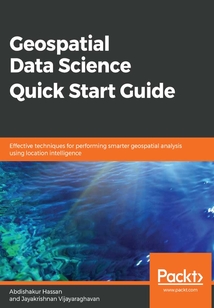舉報 

會員
Geospatial Data Science Quick Start Guide
Datascientists,whohaveaccesstovastdatastreams,areabitmyopicwhenitcomestointrinsicandextrinsiclocation-baseddataandaremissingoutontheintelligenceitcanprovidetotheirmodels.Thisbookdemonstrateseffectivetechniquesforusingthepowerofdatascienceandgeospatialintelligencetobuildeffective,intelligentdatamodelsthatmakeuseoflocation-baseddatatogiveusefulpredictionsandanalyses.Thisbookbeginswithaquickoverviewofthefundamentalsoflocation-baseddataandhowtechniquessuchasExploratoryDataAnalysiscanbeappliedtoit.Wethendelveintospatialoperationssuchascomputingdistances,areas,extents,centroids,bufferpolygons,intersectinggeometries,geocoding,andmore,whichaddsadditionalcontexttolocationdata.Movingahead,youwilllearnhowtoquicklybuildanddeployageo-fencingsystemusingPython.Lastly,youwilllearnhowtoleveragegeospatialanalysistechniquesinpopularrecommendationsystemssuchascollaborativefilteringandlocation-basedrecommendations,andmore.Bytheendofthebook,youwillbearockstarwhenitcomestoperforminggeospatialanalysiswithease.
目錄(136章)
倒序
- coverpage
- Title Page
- Copyright and Credits
- Geospatial Data Science Quick Start Guide
- Dedication
- About Packt
- Why subscribe?
- Packt.com
- Contributors
- About the authors
- About the reviewers
- Packt is searching for authors like you
- Preface
- Who this book is for
- What this book covers
- To get the most out of this book
- Download the example code files
- Download the color images
- Conventions used
- Get in touch
- Reviews
- Introducing Location Intelligence
- Location data
- Understanding location data from various perspectives
- From a business perspective
- From a technical perspective
- From a data perspective
- Types of location data
- Location data intelligence
- Application of location data intelligence
- User or customer perspective
- Venue or business perspective
- Location data science versus data science
- Data science
- Location (spatial) data science
- A primer on Google Colaboratory and Jupyter Notebooks
- Summary
- Consuming Location Data Like a Data Scientist
- Exploratory data analysis
- Handling missing values
- Handling time values
- Time values as a feature
- Handling unrelated data
- Spatial data processing
- Taxi zones in New York
- Visualization of taxi zones
- Spatial joins
- Calculating distances
- Haversine distance
- Manhattan distance
- Error metric
- Interpreting errors
- Building the model
- Validation data and error metrics
- Summary
- Performing Spatial Operations Like a Pro
- GeoDataFrames and geometries
- Geographic coordinates and geometries
- Accessing the data
- Geometry
- Coordinate reference systems
- GeoDataFrames
- Spatial operations
- Projections
- Buffer analysis
- Spatial joins
- Location data visualization
- Summary
- Making Sense of Humongous Location Datasets
- K-means clustering
- The crime dataset
- Cleaning data
- Converting into a GeoDataFrame
- K-means clustering with scikit-learn
- Density-Based Spatial Clustering Applications with Noise
- Detecting outliers
- Detecting clusters
- Spatial autocorrelation
- Points in a polygon
- Global spatial autocorrelation
- The choropleth map
- Spatial similarity and spatial weights
- Local spatial autocorrelation
- Summary
- Nudging Check-Ins with Geofences
- Geofencing
- Geofencing applications
- Marketing and geofencing
- Geometry and topology (lines and polygons)
- Line geometries
- Polygon geometries
- Topology – points in a polygon
- Geofencing with Plotly
- Masking
- Plotly interactive maps
- Summary
- Let's Build a Routing Engine
- Fundamentals of graph data structure
- Directional graphs
- Weighted graphs
- Shortest path analysis on a simple graph
- Dijkstra's algorithm
- Calculating Dijkstra's shortest path
- Calculating Dijkstra shortest path length
- Calculating single source Dijkstra path length
- Turning a simple DataFrame into graphs
- Building a graph based on a road network
- Open Street Maps data
- Exploring the road data
- Reading and exploding the geometry
- Calculating the distance of edges
- Finding a proxy for maximum speed
- Accounting for directionality
- Calculating drivetime
- Building the graph
- Shortest path analyses on the road network graph
- Dijkstra's shortest path analysis
- Dijkstra's shortest path cost
- Single source Dijkstra's shortest path cost
- Concept of isochrones
- Constructing an isochrone
- Summary
- Getting Location Recommender Systems
- Exploratory data analysis
- Rating data
- Restaurants data
- Recommender systems
- KNNWithMeans
- SVDpp
- Comparison and interpretations
- Location-based recommenders
- Summary
- Other Books You May Enjoy
- Leave a review - let other readers know what you think 更新時間:2021-06-24 13:48:39
推薦閱讀
- 大數(shù)據(jù)技術與應用基礎
- Hands-On Graph Analytics with Neo4j
- 腦動力:C語言函數(shù)速查效率手冊
- Hands-On Artificial Intelligence on Amazon Web Services
- INSTANT Varnish Cache How-to
- VB語言程序設計
- 四向穿梭式自動化密集倉儲系統(tǒng)的設計與控制
- 人工智能實踐錄
- 網絡安全與防護
- Web編程基礎
- Web璀璨:Silverlight應用技術完全指南
- 分布式Java應用
- Appcelerator Titanium Smartphone App Development Cookbook(Second Edition)
- 7天精通Photoshop CS5平面視覺設計
- 多媒體技術應用教程
- Learn T-SQL Querying
- 局域網應用一點通
- Office 2007典型應用四合一
- 微機原理及接口技術
- 精通LabVIEW 8.x
- Google Cloud Platform Administration
- SAS for Finance
- Big Data Analysis with Python
- Python Reinforcement Learning Projects
- Puppet for Containerization
- 大數(shù)據(jù)與人工智能導論
- 深入淺出PyTorch:從模型到源碼
- ServiceNow IT Operations Management
- PostgreSQL 11 Administration Cookbook
- Flink原理、實戰(zhàn)與性能優(yōu)化

